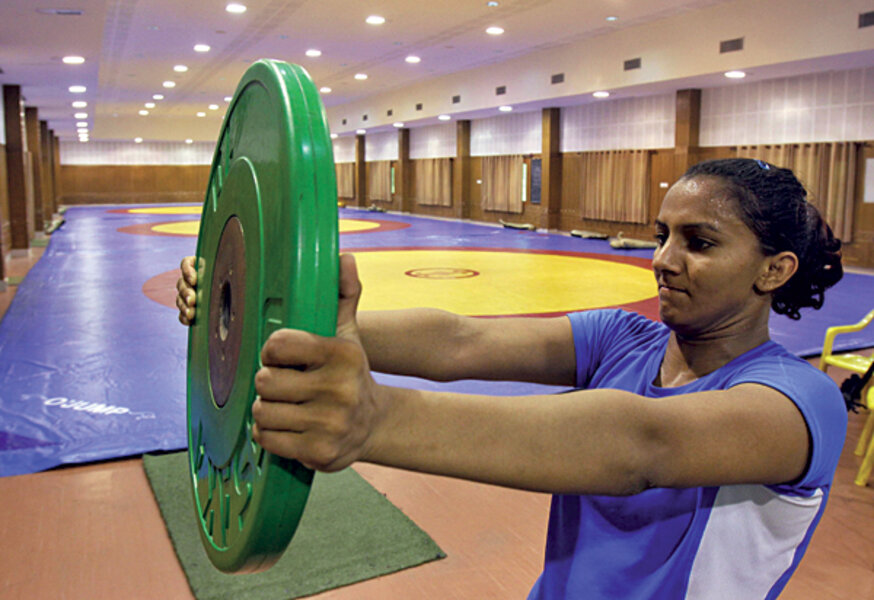How an Indian wrestler defied gender taboos
Loading...
| New delhi
With no access to padded mats, Geeta Phogat grew up wrestling on a mud floor in an enclosure next to a cattle shed. It was the best training facility that her father, a poor farmer in rural India, could build for his daughter, who he hoped would one day become a world-class athlete.
Yet a lack of mats may have been the least of her problems. As a young girl in Balali, a tiny agricultural village in Haryana, a traditionally conservative state in northern India, Geeta wasn't supposed to be wrestling at all.
Haryana is a place where female children are often thought undesirable and subject to sex-selective abortions. Women's education and work opportunities are frequently cut short by arranged marriages at an early age. Females in her village wear salwar kameez, traditional cotton pajamas, not track suits or wrestling gear.
Yet today, after years of pinning taboos, Geeta will represent her country at the London Games – as the first female Olympic wrestler in Indian history. Her mere presence on the foam pads of London symbolizes a shift in one of India's longstanding gender biases. Women can wrestle.
While Geeta has been unusual in breaking traditions, she's gotten a lot of help from her dad.
"When Geeta started wrestling, we had to deal with a lot of pushback from the community," says Mahavir Singh Phogat, her father and coach. "People told me I should be ashamed of myself for letting my daughters wrestle." (Geeta's three younger sisters also wrestle.) "People in the village and family said no one would ever want to marry my daughters and I was bringing shame to my family."
Geeta says that even in those difficult times her father was always her biggest supporter.
"My father always told my sisters and me that once you succeed, people will automatically be quiet," she says. "And he was right."
The 23-year-old Olympian notes that people's attitudes began to change two years ago after she won a gold medal in the 55 kilogram (121 pound) women's free-style wrestling division at the Commonwealth Games in New Delhi. "Now my grandmother, who used to want sons, says that she does not really want boys anymore. She says I'm the lion of the family."
Mahavir, a former member of India's national wrestling team, says that from the time Geeta was a little girl watching the sport with him on TV, he always believed that she and her sisters would become world champion wrestlers. When female free-style wrestling became an official Olympic sport in 2004, that dream became a possible reality.
Still, it hasn't been an easy journey. Besides the lack of training facilities, Geeta spent her teenage years doing something unthinkable in India – wrestling boys – because there were no girls to compete against. To get her into competitions, Mahavir had to borrow money from friends and family.
After she started winning, the Indian government and Mittal Champions Trust, a sporting initiative bankrolled by a wealthy Indian family, provided some help. But he says India's resources still lag far behind other nations. The country has only won 20 Olympic medals.
"The Indian government has been asleep to sports for a long time," says Mahavir. "Unlike other countries, such as China, they invest virtually nothing in their athletes."
Yet he vows to continue to trumpet the sport – and women's participation in it. "When you have a country that has had a female prime minister and now has a female president, how can you not have winning female wrestlers?" he asks. "My goal is to share the message that if you give love to your daughters, they will prove to be better than the boys."
In fact, dozens of parents are now asking him to teach their daughters to wrestle.
Geeta, for her part, has come a long way since competing on mud floors. Leading up to the Olympics, she has been training with the American and Canadian female wrestling teams in Colorado Springs, Colo. As she prepares for the biggest competition of her life, she is, as with everything else, taking her dad's advice.
"I'm not going to think about a medal," she says. "I'm going to give the world the wrestling match they have come to watch."
Sunday:
Gladys Tejeda: Getting to the Olympics on borrowed shoes
Monday:
Hiroshi Hoketsu: A Japanese Olympian defies the age barrier
Kayla Harrison: An American Olympian rebuilds a life through judo and friends
Tuesday:
Mohamed Hassan Mohamed: Training for the Olympics in the shadow of war
Behdad Salimi: An Iranian Olympian carries the weight of a nation
Wednesday:
Yamilé Aldama: A British track star jumps through a tough decade
Geeta Phogat: How an Indian wrestler defied gender taboos
Thursday:
Tahmina Kohistani: Afghan sprinter tries to beat the clock - and pollution





